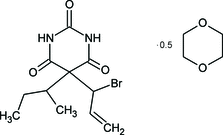Acta Crystallographica Section E
Structure Reports Online
Volume 66, Part 10 (October 2010)
organic compounds

Acta Cryst. (2010). E66, o2688 [ doi:10.1107/S1600536810038651 ]
Butallylonal 1,4-dioxane hemisolvate
T. Gelbrich, D. Rossi and U. J. Griesser
Abstract: The asymmetric unit of the title compound [systematic name: 5-(1-bromoprop-2-en-1-yl)-5-sec-butylpyrimidine-2,4,6-trione 1,4-dioxane hemisolvate], C11H15BrN2O3·0.5C4H8O2, contains one half-molecule of 1,4-dioxane and one molecule of butallylonal, with an almost planar barbiturate ring [largest deviation from the mean plane = 0.049 (5) Å]. The centrosymmetric dioxane molecule adopts a nearly ideal chair conformation. The barbiturate molecules are linked together by an N-H O hydrogen bond, giving a single-stranded chain. Additionally, each dioxane molecule acts as a bridge between two antiparallel strands of hydrogen-bonded barbiturate molecules via two hydrogen bonds, N-H
O hydrogen bond, giving a single-stranded chain. Additionally, each dioxane molecule acts as a bridge between two antiparallel strands of hydrogen-bonded barbiturate molecules via two hydrogen bonds, N-H O(dioxane)O
O(dioxane)O H-N. Thus, a ladder structure is obtained, with the connected barbiturate molecules forming the `stiles' and the bridging dioxane molecules the `rungs'.
H-N. Thus, a ladder structure is obtained, with the connected barbiturate molecules forming the `stiles' and the bridging dioxane molecules the `rungs'.
Copyright © International Union of Crystallography
IUCr Webmaster










